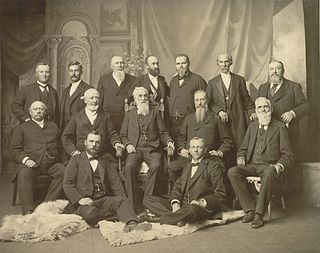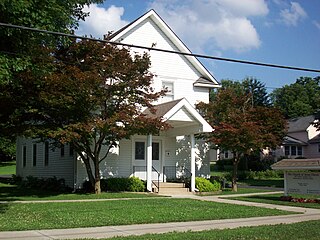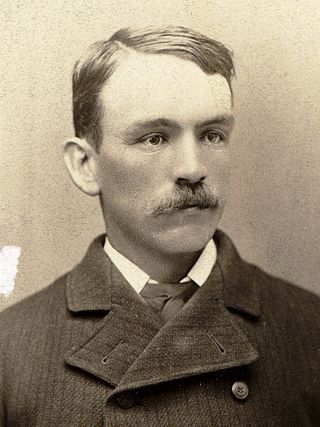In Mormonism, the Melchizedek priesthood, also referred to as the high priesthood of the holy order of God or the Holy Priesthood, after the Order of the Son of God, is the greater of the two orders of priesthood, the other being the Aaronic priesthood.

In the Church of Jesus Christ of Latter-day Saints, the Quorum of the Twelve Apostles is one of the governing bodies in the church hierarchy. Members of the Quorum of the Twelve Apostles are apostles, with the calling to be prophets, seers, and revelators, evangelical ambassadors, and special witnesses of Jesus Christ.
In the Latter Day Saint movement, priesthood is the power and authority of God given to man, including the authority to perform ordinances and to act as a leader in the church. A group of priesthood holders is referred to as a quorum.
In the Latter Day Saint movement, the President of the Church is generally considered to be the highest office of the church. It was the office held by Joseph Smith, founder of the movement, and the office assumed by many of Smith's claimed successors, such as Brigham Young, Joseph Smith III, Sidney Rigdon, and James Strang. Several other titles have been associated with this office, including First Elder of the church, Presiding High Priest, President of the High Priesthood, Trustee-in-Trust for the church, Prophet, Seer, Revelator, and Translator. Joseph Smith was known by all of these titles in his lifetime.

The True and Living Church of Jesus Christ of Saints of the Last Days (TLC) is a breakaway sect of the Church of Jesus Christ of Latter-day Saints. It is headquartered in Manti, Utah, United States, where as of 2004 it maintained a membership of 300 to 500 adherents. The church maintains a meetinghouse in downtown Manti, and in the past also owned the Red Brick Store, also downtown.

The Church of Jesus Christ (Cutlerite) is a denomination of the Latter Day Saint movement headquartered in Independence, Missouri, United States. The church derives its epithet from its founder, Alpheus Cutler, a member of the Nauvoo High Council and of Joseph Smith's Council of Fifty. Cutler justified his establishment of an independent church organization by asserting that God had "rejected" Smith's organization—but not his priesthood—following Smith's death, but that Smith had named Cutler to a singular "Quorum of Seven" in anticipation of this event, with a unique prerogative to reorganize the church that no one beyond this group possessed. Hence, Cutler's organization claims to be the only legitimate Latter Day Saint church in the world today. Currently, it has only one branch, located in Independence. The Cutlerite church retains an endowment ceremony believed to date to the Nauvoo period, practices the United Order of Enoch, and accepts baptism for the dead, but not eternal marriage or polygamy.

The Latter Day Saint movement is the collection of independent church groups that trace their origins to a Christian Restorationist movement founded by Joseph Smith in the late 1820s.

"The Council of Fifty" was a Latter Day Saint organization established by Joseph Smith in 1844 to symbolize and represent a future theocratic or theodemocratic "Kingdom of God" on the earth. Smith prophetically claimed that this Kingdom would be established in preparation for the Millennium and the Second Coming of Jesus.

Mormon fundamentalism is a belief in the validity of selected fundamental aspects of Mormonism as taught and practiced in the nineteenth century, particularly during the administrations of Joseph Smith, Brigham Young, and John Taylor, the first three presidents of the Church of Jesus Christ of Latter-day Saints. Mormon fundamentalists seek to uphold tenets and practices no longer held by mainstream Mormons. The principle most often associated with Mormon fundamentalism is plural marriage, a form of polygyny first taught in the Latter Day Saint movement by the movement's founder, Smith. A second and closely associated principle is that of the United Order, a form of egalitarian communalism. Mormon fundamentalists believe that these and other principles were wrongly abandoned or changed by the LDS Church in its efforts to become reconciled with mainstream American society. Today, the LDS Church excommunicates any of its members who practice plural marriage or who otherwise closely associate themselves with Mormon fundamentalist practices.

The Apostolic United Brethren (AUB) is a Mormon fundamentalist group that practices polygamy. The AUB has had a temple in Mexico, since at least the 1990s, an endowment house in Utah since the early 1980s and several other locations of worship to accommodate their members in Wyoming, Idaho, and Montana.

Lorin Calvin Woolley was an American proponent of plural marriage and one of the founders of the Mormon fundamentalist movement. As a young man in Utah Territory, Woolley served as a courier and bodyguard for polygamous leaders of the Church of Jesus Christ of Latter-day Saints in hiding during the federal crusade against polygamy. His career as a religious leader in his own right commenced in the early twentieth century, when he began claiming to have been set apart to keep plural marriage alive by church president John Taylor in connection with the 1886 Revelation. Woolley's distinctive teachings on authority, morality, and doctrine are thought to provide the theological foundation for nearly ninety percent of Mormon fundamentalist groups.

Joseph White Musser was a Mormon fundamentalist leader.

The Righteous Branch of the Church of Jesus Christ of Latter-day Saints, also known as The Righteous Branch, The Branch Church, The Peterson Group and Christ's Church, is a fundamentalist Mormon sect of the Latter Day Saint movement. It is based in Iron County, Utah.

Charles Frederick Zitting was a Mormon fundamentalist leader of the community in Short Creek, Arizona.

The Short Creek Community, founded in 1913, began as a small ranching town in the Arizona Strip. In the 1930s it was settled by Mormon fundamentalists.
The Centennial Park group is a fundamentalist Mormon group, with approximately 1,500 members that is headquartered in Centennial Park, Arizona. The Centennial Park group broke with Leroy S. Johnson, leader and senior member of the Priesthood Council of the Fundamentalist Church of Jesus Christ of Latter-Day Saints, in the early 1980s. There is no formal relationship between the FLDS Church and the Centennial Park community. The group is also known as the "Second Ward", "The Work of Jesus Christ" and "The Work".
In the mid 19th-century, under the direction of the prophet Joseph Smith and other prominent leaders such as Brigham Young, The Church of Jesus Christ of Latter-day Saints taught that a world government would exist upon the earth during the end times. The world government would be known as the Kingdom of God on earth. It was taught that this Kingdom would rule over all the people of the earth, and would allow each individual to live under true freedom and liberty.

The Council of Friends was one of the original expressions of Mormon fundamentalism, having its origins in the teachings of Lorin C. Woolley, a courier and bodyguard for polygamous leaders of the Church of Jesus Christ of Latter-day Saints, who was excommunicated in 1924.

The following outline is provided as an overview of and a topical guide to the Church of Jesus Christ of Latter-day Saints.












